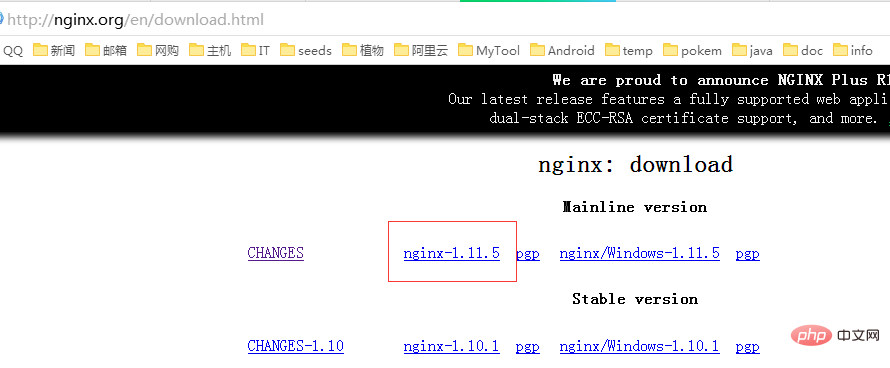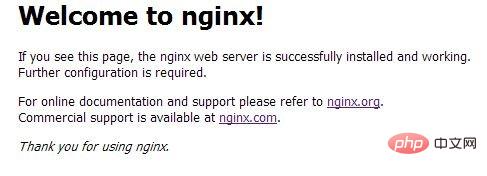 Operation and Maintenance
Operation and Maintenance
 Nginx
Nginx
 How to install Nginx and configure automatic startup on CentOS7
How to install Nginx and configure automatic startup on CentOS7
How to install Nginx and configure automatic startup on CentOS7
1. Download the installation package from the official website
Choose the version suitable for Linux. Here, select the latest version. Download it locally and upload it to the server or download it directly with the wget command under centos.

Switch to the /usr/local directory and download the software package
# cd /usr/local # wget http://nginx.org/download/nginx-1.11.5.tar.gz
2. Install nginx
First execute the following command to install the nginx dependent library. If the dependent library is missing, the installation may fail. For details, please refer to the error message at the end of the article.
# yum install gcc-c++ # yum install pcre # yum install pcre-devel # yum install zlib # yum install zlib-devel # yum install openssl # yum install openssl-devel
Extract the installation package
# tar -zxvf nginx-1.11.5.tar.gz
nginx was decompressed to the /usr/local/nginx-1.11.5 directory (do not decompress the compressed package to the /usr/local/nginx directory or rename the decompressed directory to nginx (because nginx will be installed in the /usr/local/nginx directory by default), switch to the nginx-1.11.5/ directory
# cd /usr/local/nginx-1.11.5/
Execute # ./configure
# ./configure
This operation will detect the current system environment to ensure that nginx can be successfully installed. After performing this operation, the following prompts may appear:
checking for os
linux 3.10.0-123.el7.x86_64 x86_64
checking for c compiler ... not found
./configure: error: c compiler cc is not found
If the above error message appears, execute yum install gcc-c to install gcc,
./configure: error: the http rewrite module requires the pcre library.
You can either disable the module by using --without-http_rewrite_module
option, or install the pcre library into the system, or build the pcre library
statically from the source with nginx by using --with-pcre=
If the above prompt appears, it means that the pcre library is missing
./configure: error: the http gzip module requires the zlib library.
you can either disable the module by using --without-http_gzip_module
option, or install the zlib library into the system, or build the zlib library
Statically from the source with nginx by using --with-zlib=
If the above prompt appears, it means that the zlib library is missing
If not A ./configure: error prompt appears, indicating that nginx can be installed in the current environment. Execute make and make install to compile nginx
# make # make install
. If there are no errors, it means that nginx has been successfully installed. The default installation location is /usr/local/nginx , the previous /usr/local/nginx-1.11.5/ can be deleted.
If cp: 'conf/koi-win' and '/usr/local/nginx/conf/koi-win' are the same file appears, it may be that you decompressed the installation package to /usr /local/nginx directory, the solution is to rename the directory to another name and then execute make, make install.
3. Configure nginx to boot up
switch Go to the /lib/systemd/system/ directory and create the nginx.service file vim nginx.service
# cd /lib/systemd/system/ # vim nginx.service
The content of the file is as follows:
[unit] description=nginx after=network.target [service] type=forking execstart=/usr/local/nginx/sbin/nginx execreload=/usr/local/nginx/sbin/nginx reload execstop=/usr/local/nginx/sbin/nginx quit privatetmp=true [install] wantedby=multi-user.target
Exit and save the file, execute systemctl enable nginx.service to enable nginx Start up
# systemctl enable nginx.service
systemctl start nginx.service Start nginx
systemctl stop nginx.service End nginx
systemctl restart nginx.service Restart nginx
4. Verify whether the installation is successful
Enter http://server ip/ If you can see the nginx interface, it means the installation is successful

The above is the detailed content of How to install Nginx and configure automatic startup on CentOS7. For more information, please follow other related articles on the PHP Chinese website!

Hot AI Tools

Undress AI Tool
Undress images for free

Undresser.AI Undress
AI-powered app for creating realistic nude photos

AI Clothes Remover
Online AI tool for removing clothes from photos.

Clothoff.io
AI clothes remover

Video Face Swap
Swap faces in any video effortlessly with our completely free AI face swap tool!

Hot Article

Hot Tools

Notepad++7.3.1
Easy-to-use and free code editor

SublimeText3 Chinese version
Chinese version, very easy to use

Zend Studio 13.0.1
Powerful PHP integrated development environment

Dreamweaver CS6
Visual web development tools

SublimeText3 Mac version
God-level code editing software (SublimeText3)
 How to execute php code after writing php code? Several common ways to execute php code
May 23, 2025 pm 08:33 PM
How to execute php code after writing php code? Several common ways to execute php code
May 23, 2025 pm 08:33 PM
PHP code can be executed in many ways: 1. Use the command line to directly enter the "php file name" to execute the script; 2. Put the file into the document root directory and access it through the browser through the web server; 3. Run it in the IDE and use the built-in debugging tool; 4. Use the online PHP sandbox or code execution platform for testing.
 After installing Nginx, the configuration file path and initial settings
May 16, 2025 pm 10:54 PM
After installing Nginx, the configuration file path and initial settings
May 16, 2025 pm 10:54 PM
Understanding Nginx's configuration file path and initial settings is very important because it is the first step in optimizing and managing a web server. 1) The configuration file path is usually /etc/nginx/nginx.conf. The syntax can be found and tested using the nginx-t command. 2) The initial settings include global settings (such as user, worker_processes) and HTTP settings (such as include, log_format). These settings allow customization and extension according to requirements. Incorrect configuration may lead to performance issues and security vulnerabilities.
 How to limit user resources in Linux? How to configure ulimit?
May 29, 2025 pm 11:09 PM
How to limit user resources in Linux? How to configure ulimit?
May 29, 2025 pm 11:09 PM
Linux system restricts user resources through the ulimit command to prevent excessive use of resources. 1.ulimit is a built-in shell command that can limit the number of file descriptors (-n), memory size (-v), thread count (-u), etc., which are divided into soft limit (current effective value) and hard limit (maximum upper limit). 2. Use the ulimit command directly for temporary modification, such as ulimit-n2048, but it is only valid for the current session. 3. For permanent effect, you need to modify /etc/security/limits.conf and PAM configuration files, and add sessionrequiredpam_limits.so. 4. The systemd service needs to set Lim in the unit file
 Specific steps to configure the self-start of Nginx service
May 16, 2025 pm 10:39 PM
Specific steps to configure the self-start of Nginx service
May 16, 2025 pm 10:39 PM
The steps for starting Nginx configuration are as follows: 1. Create a systemd service file: sudonano/etc/systemd/system/nginx.service, and add relevant configurations. 2. Reload the systemd configuration: sudosystemctldaemon-reload. 3. Enable Nginx to boot up automatically: sudosystemctlenablenginx. Through these steps, Nginx will automatically run when the system is started, ensuring the reliability and user experience of the website or application.
 What are the Debian Nginx configuration skills?
May 29, 2025 pm 11:06 PM
What are the Debian Nginx configuration skills?
May 29, 2025 pm 11:06 PM
When configuring Nginx on Debian system, the following are some practical tips: The basic structure of the configuration file global settings: Define behavioral parameters that affect the entire Nginx service, such as the number of worker threads and the permissions of running users. Event handling part: Deciding how Nginx deals with network connections is a key configuration for improving performance. HTTP service part: contains a large number of settings related to HTTP service, and can embed multiple servers and location blocks. Core configuration options worker_connections: Define the maximum number of connections that each worker thread can handle, usually set to 1024. multi_accept: Activate the multi-connection reception mode and enhance the ability of concurrent processing. s
 Configure PhpStorm and Docker containerized development environment
May 20, 2025 pm 07:54 PM
Configure PhpStorm and Docker containerized development environment
May 20, 2025 pm 07:54 PM
Through Docker containerization technology, PHP developers can use PhpStorm to improve development efficiency and environmental consistency. The specific steps include: 1. Create a Dockerfile to define the PHP environment; 2. Configure the Docker connection in PhpStorm; 3. Create a DockerCompose file to define the service; 4. Configure the remote PHP interpreter. The advantages are strong environmental consistency, and the disadvantages include long startup time and complex debugging.
 What are the SEO optimization techniques for Debian Apache2?
May 28, 2025 pm 05:03 PM
What are the SEO optimization techniques for Debian Apache2?
May 28, 2025 pm 05:03 PM
DebianApache2's SEO optimization skills cover multiple levels. Here are some key methods: Keyword research: Use tools (such as keyword magic tools) to mine the core and auxiliary keywords of the page. High-quality content creation: produce valuable and original content, and the content needs to be conducted in-depth research to ensure smooth language and clear format. Content layout and structure optimization: Use titles and subtitles to guide reading. Write concise and clear paragraphs and sentences. Use the list to display key information. Combining multimedia such as pictures and videos to enhance expression. The blank design improves the readability of text. Technical level SEO improvement: robots.txt file: Specifies the access rights of search engine crawlers. Accelerate web page loading: optimized with the help of caching mechanism and Apache configuration
 How to implement automated deployment of Docker on Debian
May 28, 2025 pm 04:33 PM
How to implement automated deployment of Docker on Debian
May 28, 2025 pm 04:33 PM
Implementing Docker's automated deployment on Debian system can be done in a variety of ways. Here are the detailed steps guide: 1. Install Docker First, make sure your Debian system remains up to date: sudoaptupdatesudoaptupgrade-y Next, install the necessary software packages to support APT access to the repository via HTTPS: sudoaptinstallapt-transport-httpsca-certificatecurlsoftware-properties-common-y Import the official GPG key of Docker: curl-






